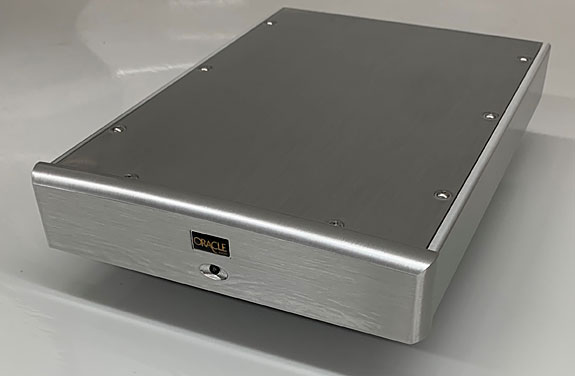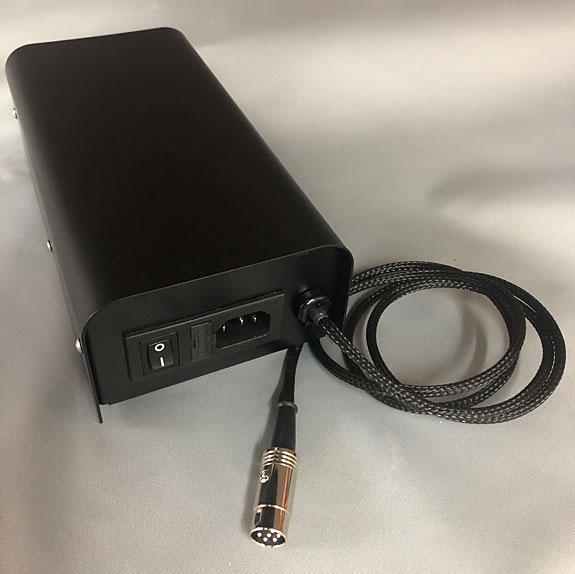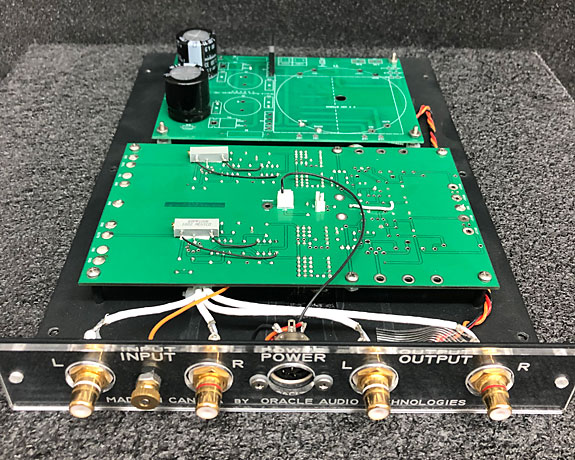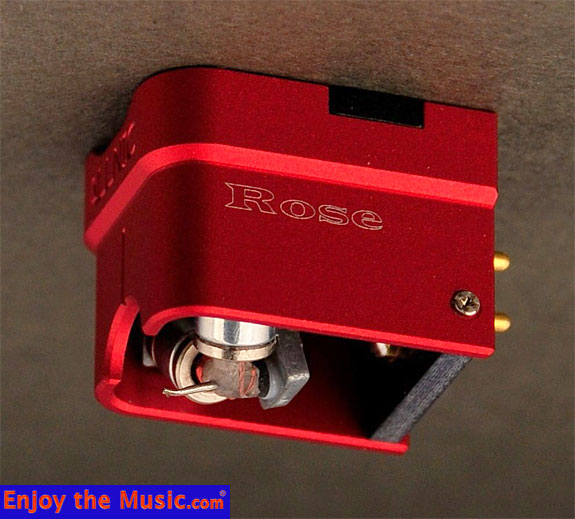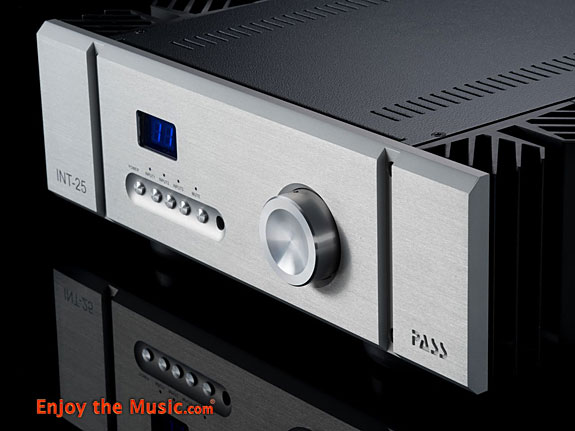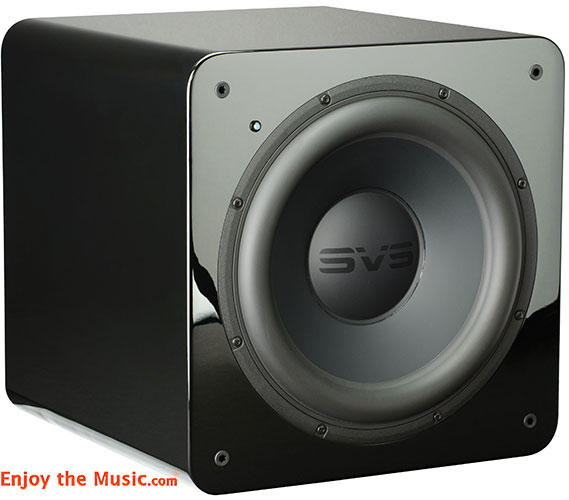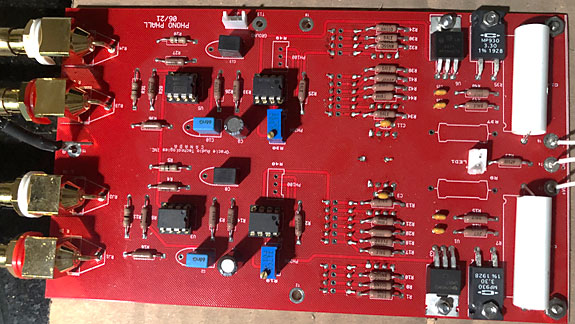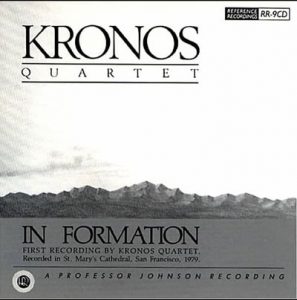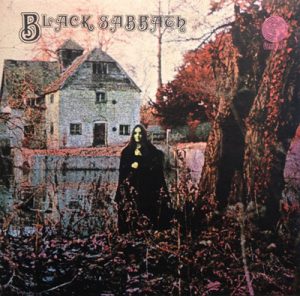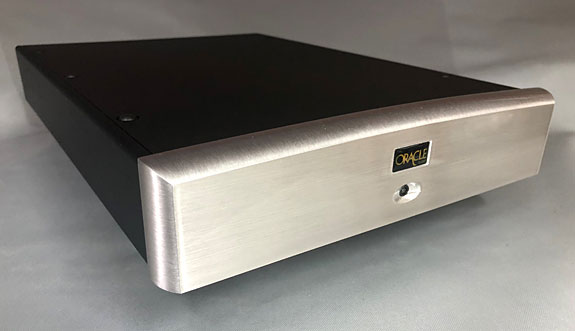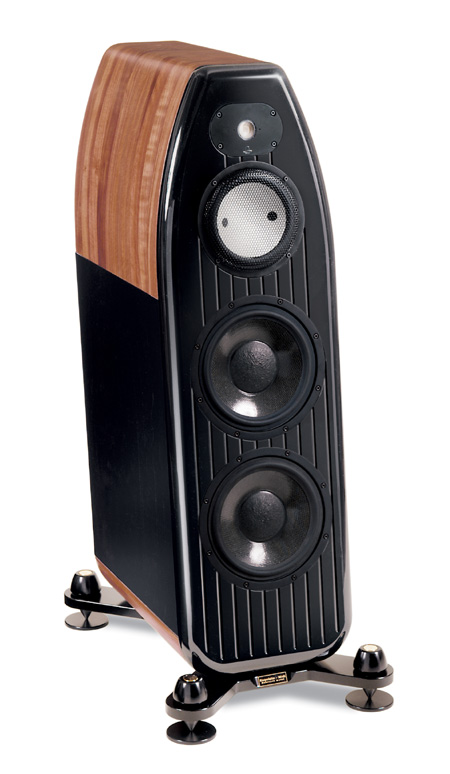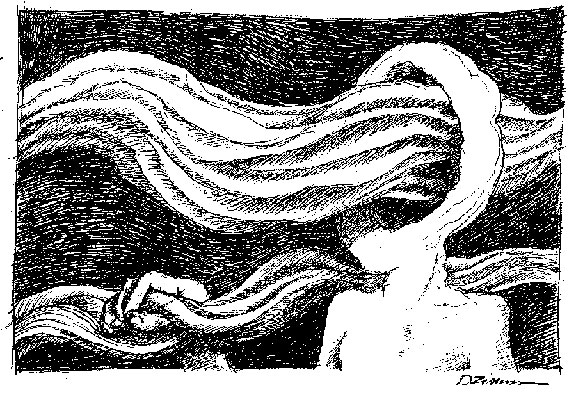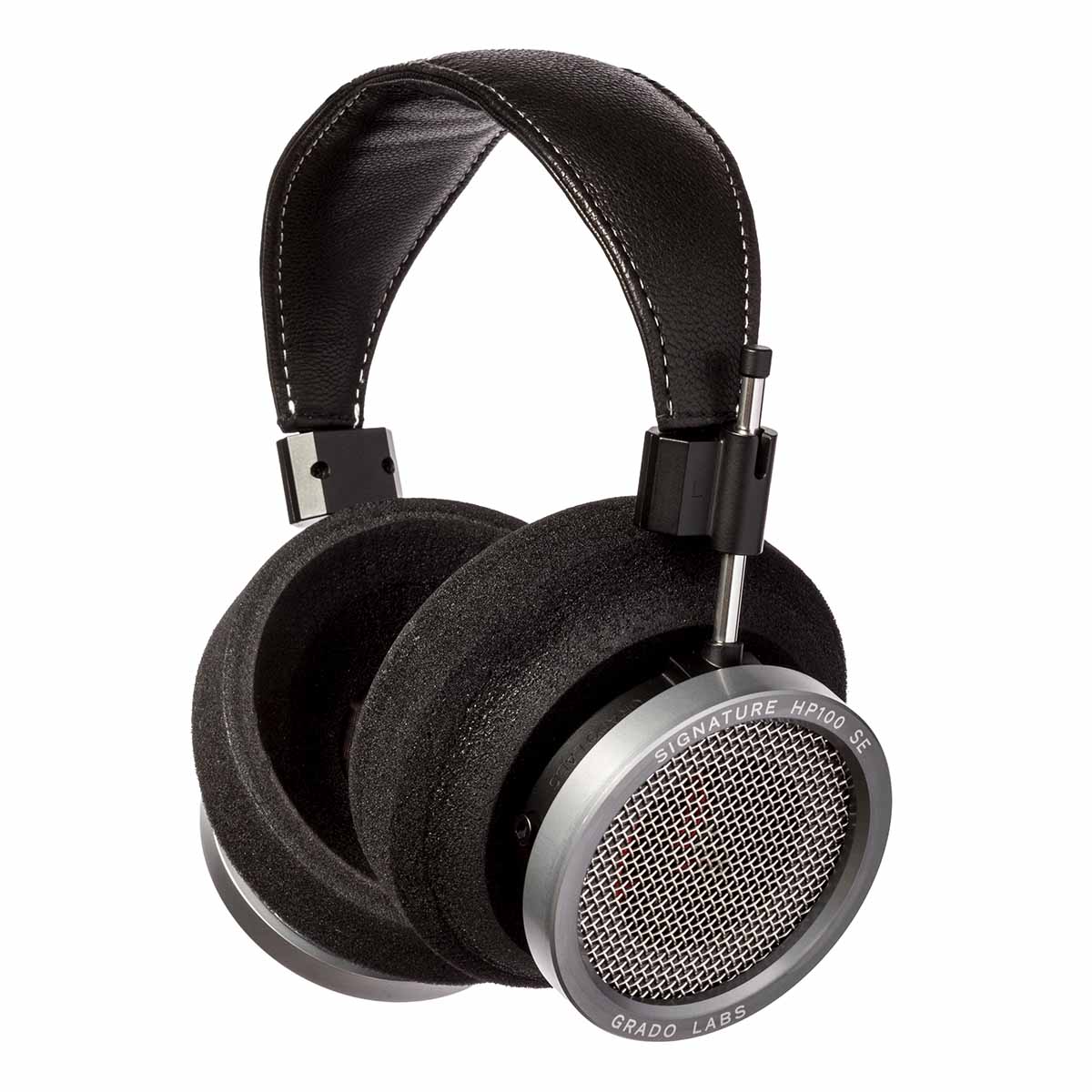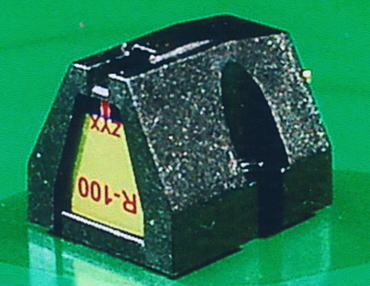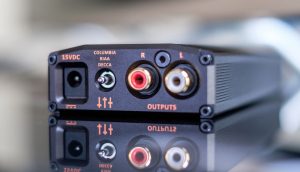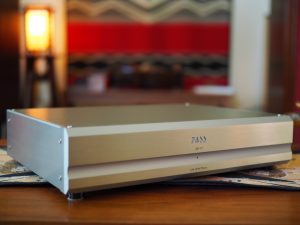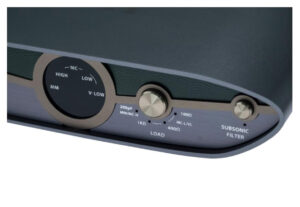World Premiere Review!
A quiet background, and extended response, making instruments sound real.
With this article, Positive Feedback continues its content-sharing relationship with Enjoy the Music where Tom Lyle shares his thoughts on the Oracle Audio PH200 Mk III Phono Preamplifier.
Dr. David W. Robinson, Editor-in-Chief
I'll start this review of Oracle Audio Technologies' PH200 Mk III with a disclaimer, of sorts: My first truly "high-end" turntable was manufactured by Oracle. It was a used, heavily modified Oracle Delphi, a version of one of their first turntable models, which replaced my trusty AR. On the AR was a Grace G-707 tonearm, which I then used on the Oracle. I was in audiophile heaven. This Oracle Delphi was my "reference" turntable rig for quite some time, although I didn't use the term "reference" back then. In many ways, I miss that turntable. It certainly turned heads when "citizens" saw it perched upon the top of my equipment rack.
Fast-forward to the 21st Century; the Delphi was long gone, but I was lucky enough to review the first version of Oracle's Paris turntable, which came with a modified and re-branded Pro-Ject 9cc tonearm. For a combined price of about ~$4000 back in 2012 Dollars, its price was not what most would consider "entry-level," but neither was its sound quality. I called it "a great looking, solidly built, and superb-sounding turntable." The Paris is now in its Mk V version.
I felt like I hit the jackpot in 2014 when I had the opportunity to review the 20/20 Special Award, and 25th Anniversary Legendary Performances Award-winning $12,000 Oracle Delphi Mk VI, fitted with a $6000 SME tonearm. I fell in love with this setup. I wondered if they ever noticed my claw marks on the turntable's carton made when UPS arrived to pick it up.
Oracle
Now I have the opportunity to review Oracle's PH200 Mk III phono preamplifier, the "III" indicating that Oracle upgrades its components regularly. One of the many changes that were introduced with the PH200 Mk III is the shape of its all-aluminum cabinet, which has been slightly altered (available a fine-textured black, black with a high-gloss brushed aluminum front panel, and high-gloss brushed aluminum).
More importantly, the innards of this dual-mono phono preamp have been improved. Among other upgrades, it now includes higher-precision Dale resistors, plus inside its outboard external power supply is a toroidal transformer that double the output to two 15 VAC @ 50VA via a DIN plug that attaches to the rear panel of the phono preamp's main unit.
The PH200 Mk III, like the majority of phono preamps, has two stages. Burr-Brown OPA 228P op-amps are used for this phono preamplifier's first stage, which is responsible for amplifying the minuscule amount of signal coming from the phono cartridge. Burr-Brown OPA 627AP op-amps are used in PH200 Mk III's second stage, which amplifies the signal to the required output level.
Oracle claims that its amplifying stages were designed to optimize its signal-to-noise ratio. A high signal-to-noise specification results in a host of positive sonic characteristics, but in their literature, Oracle stresses that with this high SNR the PH200 Mk III will have "a very rapid and high dynamic contrast giving to the Ph200 all its musicality!"
Not only this but this phono preamp's DC voltage is generated the moment it enters the phono preamp's main cabinet, where it is connected to its printed circuit board (PCB), thus shortening its signal path. The DC conversion and DC filtering plus tweaking are done inside the PH200 Mk III chassis. This makes for a shorter signal path has been proven to make a component sound quieter and more dynamic.
Settings
The PH200 Mk III offers five different moving coil cartridge load settings, from 100 Ohm to 47kOhms, and three different variable gain settings, 41.5, 52, and 62 dB of gain, the lowest used for moving magnet (MM) cartridges. The listener accesses these options through a door located on the bottom of the phono preamp, where there are jumper configurations on both the left and right channels. The different values of load impedance and gain that are possible with the PH200 Mk III aren't as numerous as some more expensive phono stages but should make this phono preamplifier compatible with just about every moving magnet (MM) and moving coil (MC) phono cartridge that owners of the Oracle PH200 Mk III are likely to use.
I'm constantly reminding audiophiles about the significance of an audio component's power supply. When I first saw a photo of the PH200 Mk III, because of its relatively low price, I assumed that it would use a power supply that attaches itself to the AC wall-receptacle that we like to call a "wall-wart." I soon learned that I was wrong. The "highly regulated and filtered" external power supply of the PH200 Mk III connects to the main unit with an umbilical, eliminating any electrical line noise before it can access the phono stage circuitry. This power supply is nearly as large as the main unit.
Phono
Although I said that the PH200 Mk III is compatible with almost any phono cartridge, some with very low output phono cartridges might need more gain than the PH200 offers. Its highest level of gain is a healthy 62dB, but that level was still a bit too low for the reference low-output moving coil cartridge I use in my main system, which has a very low output of only 0.2mV. This ended up to be not very bad news, as a phono preamp in this price range and its level of features led me to believe that it would likely be used with the phono cartridges and the other equipment, I use in my second system.
In this system, the moving coil (MC) phono cartridge I used was still a low-output moving coil phono cartridge. The low-output MC phono cartridge I used in the review system was a Lyra Kleos with a significantly higher output of 0.5m. For a short time, I also used the Allnic Rose moving coil cartridge that I reviewed in May of this year, with an output of 0.4mV, with only .1mV less than the Kleos, it was still a good match with the Oracle PH200 Mk III. The Lyra Kleos was mounted on the integral tonearm of the affordably priced, yet excellent sounding Pro-Ject X2 turntable.
I connected an interconnect from the turntable to the Oracle PH200 Mk III's RCA inputs, and then from the phono preamp's outputs an interconnect to an input of the excellent Pass Laboratories INT-25, the newest resident of the system. To me, this Class A integrated amplifier sounds much more powerful than any 25-watt per channel amp I've ever heard, although the speakers I used combined with the rather "live" sounding room they were firing into doesn't need a very powerful amp to begin with.
The amp fed its signal to a pair of EgglestonWorks Isabel Signature two-way floor-standing speakers, their lowest bass augmented by 2018 Blue Note Equipment Award winning single SVSound SB-2000 subwoofer. Just for fun, near the end of the review period, I used a pair of nearly thirty-year-old Magnepan MG-2.b planar speakers, a relatively early Jim Witney design.
Impressive
The Oracle PH200 Mk III is a very impressive sounding phono preamplifier. While listening I had to keep reminding myself of this phono preamp's asking price. And not once during its audition period did I think of replacing this phono preamp with a more expensive phono preamp that was in-house, some much more expensive than the PH200 Mk III.
This Oracle phono preamp's sound (or rather, its lack of "sound") drew me in, letting the vinyl record I was playing be the deciding factor of whether or not I was hearing a recording with good sound quality. I feel as if I'm repeating what I said in many other phono preamp reviews and many other types of components besides phono stages—that I believe a high-end phono preamplifier's level of transparently boosting the electrical signal of a phono cartridge to a usable volume should be the most important trait of a phono preamp. And so should you.
Limits
Designing a preamplifier with no limits on price is likely much easier than designing one within a certain price point. When price is considered, some sonic traits are going to have to be preserved more than others. Living with this phono preamp for quite some made it clear that Oracle made some very wise decisions. Of course, reaching the highest level of transparency possible was one of them. As it should be yours, too, when shopping for a phono preamplifier.
At the same time, it seems to me that the designers of this phono preamplifier were not only engineers but artisans. If there have been sacrifices made, they were not very noticeable because these designers have ended up with a phono preamp that when I played records it somehow "knew" what instrument was being reproduced, what a specific voice sounded like, and what the engineers and producers of the recording were attempting to convey with their recording.
I realize that some of the descriptions above are a bit obtuse, but I suppose I'm trying to say that the PH200 Mk III had characteristics that make a good phono preamplifier, period. Without drawing much attention to itself, the PH200 Mk III boosted the musical signal without adding much sound of its own, which should be the goal of any audio component. I could hear more music that was being made by everyone responsible for making the recording than I was listening to at the time. Honestly, I never expected to hear from such a comparatively small and lightweight phono preamplifier (combined with its power supply it weighs in at a mere 8.5 pounds!).
Portrayed
The Oracle PH200 realistically portrayed what was coming from not only from the X2 / Kleos combination but from the record I was spinning. The PH200 Mk III's accurate reproduction took me aback. Not that I wasn't expecting the Oracle PH200 Mk III to perform admirably, but because it did this with such graceful ease.
This was evident with every record I played, but especially on acoustic instruments, voices, and those recordings made in a "real" space, My parentheses are due to my feelings in regards to those who say the studio is not a real space, since I listen to as much or more of those types of recordings as more or more than any other type of recording. I have no problem with those who judge the quality of audio gear solely on those types of recordings. But I digress.
The PH200 Mk III was able to accurately portray not only voices, instruments, and the effects that were applied to those instruments, "real" or man-made. But reverb trails made from the spaces in which they were recorded sounded sublime, such as the album by the Kronos Quartet LP In Formation on the Reference Recordings label recorded in St. Mary's Church in San Francisco.
This is an unusual recording—an album of a string quartet playing new music arrangements of blues compositions, on a premier American audiophile label. Not only was its sound quality worthy of inclusion in a high-end audio magazine, but it is also a damn good 12" mini-LP, and an excellent "demonstration disc." This LP proved that this Oracle phono preamp reveals low-level information that belied its asking price. It also showed how proficient it was in not only reproducing a lifelike-sounding depiction of the instruments performing in the string quartet, plus that humans were playing these instruments!
The PH200 Mk III reproduced this record with a striking naturalness, often making me turn my head quickly, thinking that I heard something entering my room, as when the founder of the Kronos and first violinist David Harrington would reach a crescendo higher up on his violin's fingerboard.
Again, the level of transparency of the PH200 Mk III was striking, which led me to believe that one of the reasons I was enjoying the characteristics of this Oracle phono preamp so much was because I was enjoying the sound quality of a very decent turntable setup and recording. The Lyra Kleos is a wonderful phono cartridge, and also happens to be the most expensive component of the analog front-end of the review system. The PH200's ability to accurately reproduce the Kleos cartridge's traits, including being able to distinguish similar sounding mid to upper treble sounds from each other. This phono cartridge is unmatched in this ability for a cartridge in its price range. And combined the PH200 Mk III's high level of transparency of the entire frequency range was also one of its traits, at least when compared to other phono preamps anywhere near its price.
For a relatively inexpensive phono preamplifier, its combination of a commendable level of transparency, combined with its organic reproduction of instruments was astonishing.
Switching gears, I'm one of the lucky heavy metal fans that have the first UK pressing of Black Sabbath's debut, self-titled album on the Vertigo label, this initial pressing often called a "Vertigo Swirl". I purchased this record for next to nothing back in the day while in England, and this LP is still in nearly perfect condition.
This album is a blast to listen to on a high-end analog rig. Here is an album, recorded and mixed on four-track reel-to-reel in two days that doesn't have many of the typical "audiophile" traits. Yet, I've been listening to, and a fan of this album all of my adult life, and therefore have heard many different vinyl and digital versions. Many might not feel that its recording quality doesn't merit a place on any list of great-sounding LPs. It wasn't until I heard an early Japanese pressing that I thought that it might, and was convinced that it did when I acquired a first pressing copy on the Vertigo label made in the UK. At that time my system wasn't anywhere as good as it is now, yet I could still hear that it was better than any other version I've heard before. These days, in my opinion, for those that like this type of music it is an excellent way to "test" one's system, or a component in one's system. Even if one doesn't like this type of music, my description should at least be beneficial in describing the sonic traits of the Oracle PH200 Mk III.
In absolute terms, this album's midbass up into its upper midrange is most prominent, its lowest bass and upper treble seem somewhat attenuated. I've read reviews that claim that compression was added, but to me, it sounds more akin to the result of its rather primitive recording method combined with the instruments that have been recorded at a maximum volume. "In the red" as many engineers call it, but without overload distortion. I do agree with those who compliment the overall sound of this album, calling it "super sharp", that on a good system, such as the one that the PH200 Mk III was a part of, all the instruments are separated in space, all part of a very large soundscape.
The most essential instrument on this album is Tony Iommi's distorted guitar. But that's just my opinion, and because the PH200 Mk III doesn't play favorites, it is also able to reproduce with near perfection the important sound of Black Sabbath's bassist and lyricist Geezer Butler's instrument remarkably well. The bass guitar that is reproduced doesn't reach super-deeply, but the sound of Geezer's bass is super-clean, and the PH200 Mk III is able to reproduce that signal as well as any, and better than most.
The term "sharpness" that was used by some could have been referring to this album's transient response. This, combined with a recording that sounds as close to a live mic feed as one is going to get from a band and production team that was likely using or recently using recreational drugs. With the PH200 Mk III it made it so I could imagine in my mind's ear Geezer's finger and hands plucking, strumming, and slapping his bass strings.
Of course, the raison d'être of this hard rock/metal album is what the name of their band implies, a rock band version of a horror movie, with many of their songs having what Wikipedia says are "occult themes with horror-inspired lyrics" sung in Ozzy Osbourne's high-pitched voice. Whether or not one likes this music is a matter of taste, but there's no denying their originality and execution, being the first of what shortly after would be called a "heavy metal" band.
Through the PH200 Mk III Black Sabbath's mission was clear. Bill Ward's drums pounded and the guitar, bass, and vocals also sounded loud and clear. Yes, it's a facile description, befitting the music read by my turntable's cartridge, boosted to a level by the PH200 Mk III that sounded as if the phono cartridge had a direct connection to my Pass Labs integrated amp sounded like a rock band playing in a studio playing together, on this mission.
Fact
As I touted the Oracle PH200 Mk III's sound, in the back of my mind were always thoughts of phono preamps that I have reviewed or otherwise heard that were more technically advanced than the Oracle PH200 Mk III, including some near state-of-the-art models. It goes without saying that all of these more advanced preamplifiers were much more expensive than the PH200Mk III. And of course, the PH200 fell short of these more extravagant phono preamp's ideals in many ways. Including having a quieter background, a more extended frequency response, made instruments sound more like the real thing, etc.
I mentioned before that when designing a phono preamplifier that was not a cost-no-object project, some sacrifices were going to have to be made. It is obvious to me that Oracle designed their PH200 Mk III making some very intelligent choices. So intelligent that I could use their PH200 Mk III often without caring that those more expensive phono preamplifiers that I've heard even existed!
The PH200 Mk III is an amazing work of electronic design, but also a work of art because it joins very few others that not only sound much closer to the ideal phono preamplifier, one that simply boosts the meager signal of a phono cartridge without adding sounds or a sound of their own.
Maybe Oracle just got lucky, but the magic that was installed into the PH200 Mk III cropped up when reproducing acoustic instruments and voices that contained the gestalt of those sounds. Maybe not by sounding exactly like the real thing (call me when that happens), but by containing what is necessary to hear and ponder the possible intentions of who was behind those instruments, sounds, voices, and the meaning behind what I was listening to. The PH200 Mk III got me thinking about who made the music, and how it made me feel. Do I highly recommend the Oracle PH200 Mk III phono preamplifier? Yes, I do!
Specifications
- Type: Solid-state stereo moving coil (MC) and moving magnet (MM) phono stage
- Moving Coil (MC) Settings: 100, 200, 511, 1k, 1.5k and 47k Ohm.
- Moving Magnet (MM) Setting: 47kOhm
- Input Capacitance (Moving Magnet): 150pF
- Input Sensitivity: 0,2mV and up
- Gain MC: 41.5dB, 52dB, and 62dB
- Gain MM: Must be set at 41.5 dB when set for MM with 47kOhm
- Signal-To-Noise Ratio: > -80dB
- Dimensions: 9.5" x 12.25" x 2.25" (WxDxH)
- Price: $1900 ($2120 as reviewed with full-aluminum chassis)
Oracle Audio Technologies
6136 Blvd. Bertrand Fabi
Suite 101
Sherbrooke, Quebec J1N 2P3
Canada
819.864.0480
Check out Enjoy the Music for more articles and reviews




